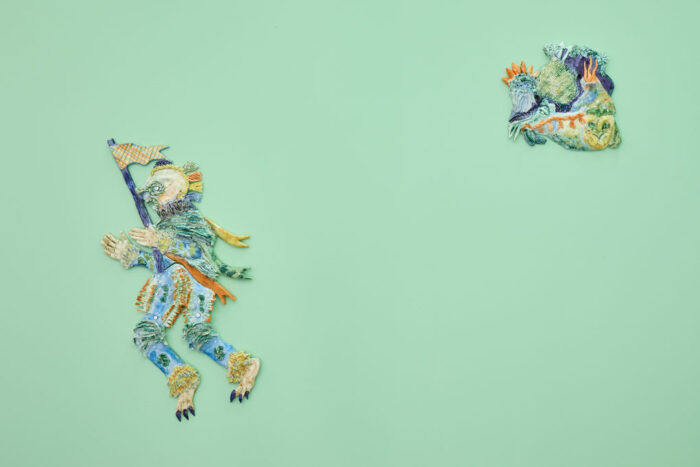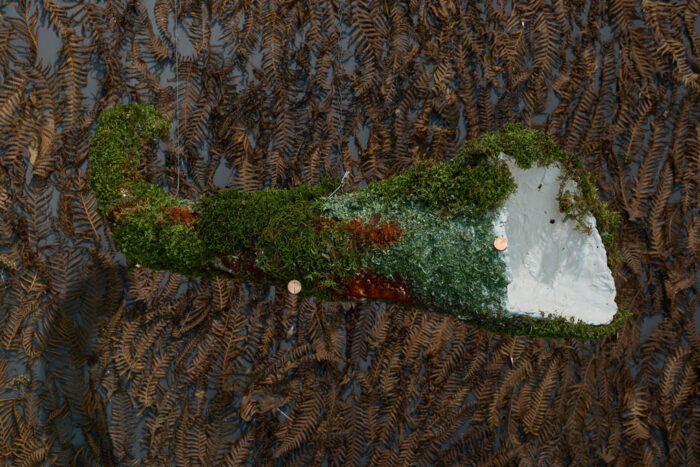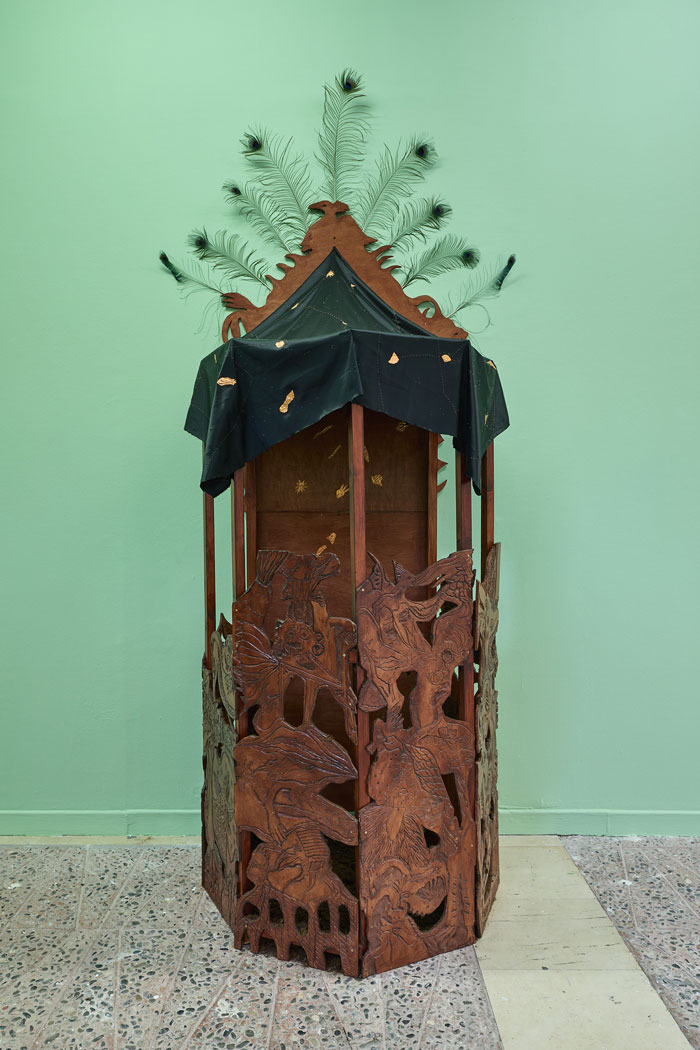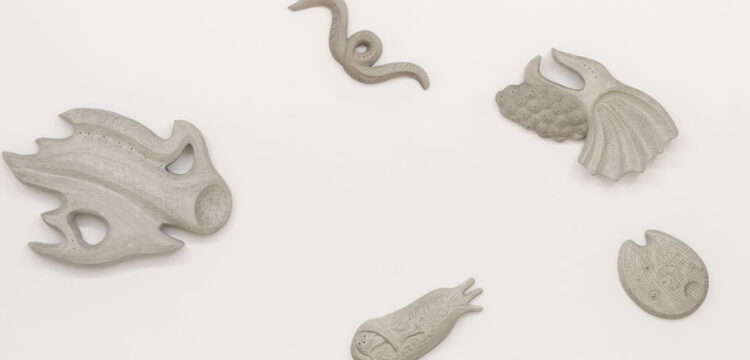Allegorical Survival
On Beatrice Celli’s ancestral imaginary
In le jardin des allégories, the Passage des fougères [Fern Pathway] finds itself transfigured by Italian artist Beatrice Celli (Villa Arson class of 2019) into a place for dreaming and collectively imagining, inspired by the history of the garden; a landscape of symbols, created by the means of a rudimentary practice including salvaging, calling forth both classicism and folklore. Her metaphorical garden is conceived as an initiatory passage, strewn with a memento mori garland, a fountain decorated with a fantastical bestiary and a pavilion designed as a cosmic confessional. The Garden of Allegories is an invented locus amoenus, an invitation to cultivate the singular world hidden deep inside us.
“To listen to the whispers of the trees and
the dispossessed, the echoes of grandmothers’ tales
and what we already know
in the deep, dark, stanchion place from
which intuition rises; the hold of the story,
the bag of stars, the spell, the dream, the crucible of our awakening.”—Sarah Shin and Ben Vickers
A syncretic alliance of creatures, stories, legends, materials and hybrid knowledge is articulated in Le Jardin des allégories, Beatrice Celli’s solo exhibition at the Centre of Contemporary Art Villa Arson in Nice, curated by Éric Mangion. The artist reflects within the Passage des Fougères on beliefs and superstitions grafted in remote and rural contexts, opening a gap in a subaltern time and a dream space. In this space, matter “is not separated from the world by well-defined boundaries; it is mixed with the world, with animals, with objects. It is a cosmic dimension, representing the entire corporeal material world in all its elements.”

Tracing a polyphony of survivals, Celli draws on the tradition of the iconography of the allegorical garden to transpose it into the wild, into an ambiguous and contradictory space that goes beyond the bipolar division between domestic and wild, where reversals, transformations and multi-sensorial states are ordinary manifestations. The correspondences between signified and signifier, what has conventionally been called classicism, the symbolism of a culture stratified by violence, are presented in a state of perturbed grace, agitated by the motions and impulse of a community’s (in)consciousness. The irrational emerges to reveal alternative worlds and visions. In fact, in her practice the artist questions collective imagination, as the reanimation of magical beliefs and the possibility of a different relationship with the environment/landscape. The preciousness of the encounter and the value of existence as well as its emanations are manifested in her interest in mysterious gestures and practices, which may be considered as non-canonical for modern society, when they are (im)possible escapes from defined orders, whispers of reason that admit the existing and then forgotten relationship between matter and spirit—attention towards an unconscious knowledge of daily transformations and wonders. They are also the ghosts of a different economy that return with their spells of “desire-power-miracle”—imagination and salvific action on reality. The works in the exhibition present themselves as a technology of spiritual transmission that open to interdependent dialogues, exorcising fears and recalling a vanishing commons. “The technique for having visions, for seeing ghosts, is in truth a technique for being seen by ghosts.”

From the chromatic background of the mint green walls—a very common color in the Baroque era, in the Provençal imagery and on the external walls of traditional Lithuanian houses—which flows into the visual and interstitial landscape in front of the garden, multiple combinations follow one another, constellations of collaborations, frayed dreams, principles of visions. The recovery of artisanal values and the overturning of myths merge in an operation of listening and reciprocity that empathically and fruitfully absorbs the multiple possibilities of cultural contaminations, rendered in a brute, spontaneous, rustic, folkloric aesthetic. The artist undoes each of these categories, by remixing, re-modulating and letting them live their own life, according to an animist vision and a cosmic hospitality. In this way she renounces a linear and uniform time that belongs to the modern society of control. She also avoids falling into the paradox identified by the ethnographer Ernesto De Martino of applying Western and ethnographic categories to “alien” cultures. Celli dissolves this paradox by using an intuitive approach that embraces the conditions of the unconscious of social life in a timeless manner. This way, each work is presented as a storytelling to recover and reinterpret sensitive traditions and knowledge. Perhaps there is an inevitable connection between craft making and storytelling, just as storytelling might be fundamental to organizing and promoting cooperation in human evolution.

Like a narrator, the artist collects the voices and oral testimonies of both her land—Abruzzo—and Lithuania—where she has spent some time lately for a residency at ACROSS for thankyouforcoming associated to the Kaunas Artists’ House—to give them back as a pleasant place, an initiatory garden where to propose, through matter, a new order of values and social ties, where “the pleasure of transmission is integrated with the contemplation of nature.” A perspective that contemplates a peaceful relationship between matter, body and reason. The narrative is transposed into the landscape of an entire community, in the writing of a language composed of voices and legends. This narrative begins with Beffa Notturna, a wooden sculpture that formally reproduces an owl perched on a branch, adorned with streamers. The initiatory moment begins with the presence of a bird usually associated with bad luck, whose material, an olive tree log that the artist has saved from her fireplace, also leads back to the ancestors. According to a legend of her village they manifest themselves in the form of an owl. Fear and anguish coexist festively through the life that feeds on the ancestors’ memory.

The Fountain of Smaragos is a ceramic work that evokes one of the five demons that, in Greek mythology, afflicted the artisan potter. Produced in Shanghai, it is a drawing with a chimerical nature where the myth of classical antiquity is also associated with medieval heraldry, in a multiplicity of interpretations: the flowing water, among other things, symbolises a pouring out of the body and hierarchies. The garland Giurlanna Berlocco is a memento mori with vegetable elements recovered from the woods, together with fake plants made by Celli with fabric of canvases created during her early years at the Academy of Urbino, and bone ashes, organic and inorganic material. The result is a material reflection between reality and fiction. The apotropaic mask Mezz’Marill is a wicker sculpture that evokes the creatures that inhabit the forest. Its realisation took place in collaboration with her grandmother, who as a woman could not practice this technique but only observe it, and who nevertheless guided the artist in its realisation. A series of ceramic bells in pastel colours, with a texture referring to the violence of animal sacrifices, disarticulates a bewitched and deviant temporality.

In the same section of space is Lunatic Pavilion, a wooden confessional that echoes the tradition of the domestic totems typical of many Lithuanian homes, whose vernacular shape and decoration covered in satin, copper votive offerings and adorned with peacock feathers, interior is sprinkled with earth, testifies how beliefs also define form. Folklore is enriched over time, expressing the presence of things that are disappearing. Sive mas sive foemina (let it be male or let it be female) is a ceramic work representing the homo selvaticus who according to a legend lives in the forest, and his life led in close relation to nature gives him a special intelligence. The title of the work refers to the magic formula used by the Romans to attract the Genius Loci, an entity considered to be of neutral gender. The work presents a tribal and eclectic aesthetic, with references to medieval but also primitive culture: a sort of shaman who, crossing a time portal, insists on a disjointed condition. The reactivation of ancient beliefs and ancestral knowledge is present in the work Grascia Corna, an installation composed of a wall of lichens, cornucopias covered by mosses and full of copper coins from which the whispers and litanies of magic and healing formulas recorded by forms of Lithuanian popular witchcraft come out. The work was made for a collective performance previously presented in the garden of the Devil’s Museum, in Kaunas, Lithuania. On that occasion Celli had organized a ritual of invocation to the devil that consisted in burying some coins in the ground and in the choral repetition by the public of the phrase coming from an old local belief “Devil Devil come to the money, Devil Devil here’s the money!”

Following the suggestion of Éric Mangion, curator of the exhibition, who had asked the artist to think about the spirit of the place, Celli has remodelled the Brutalist architecture and the garden of Villa Arson. In the garden that the artist has created, a landscape opens up where there is no longer any difference between subject and object, between environment and matter. A syncretic convocation and evocation of local spirits cross time and space to reappear from modernist expropriation as allegorical survivals.



